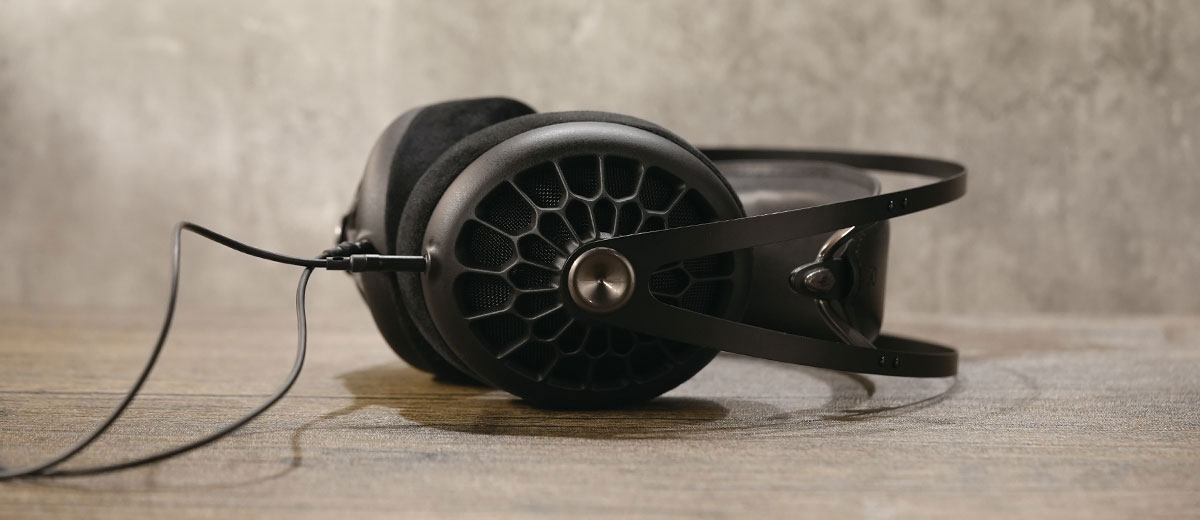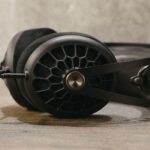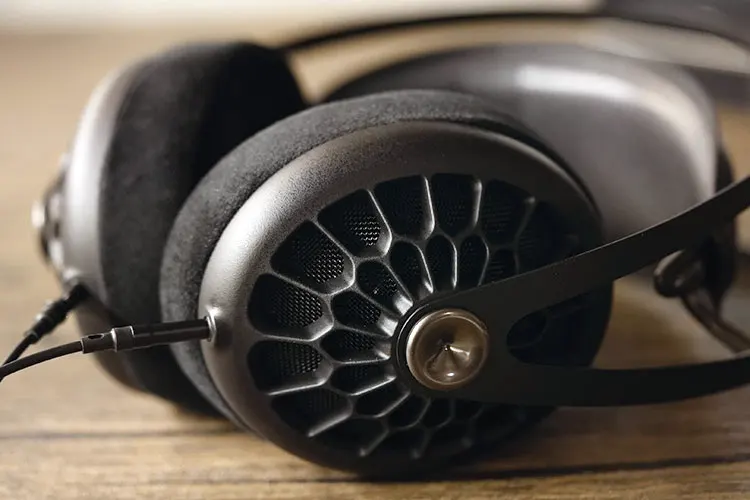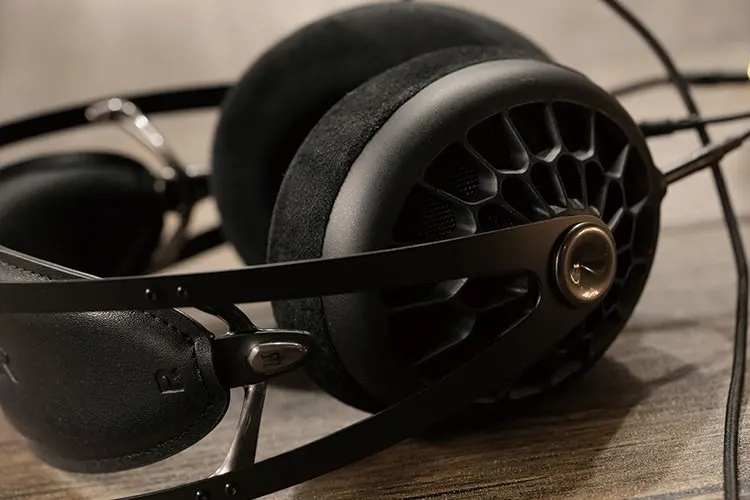In this feature, James reviews the Meze Audio 105 AER, a recently released set of open-back 50mm dynamic driver headphones priced at $399.
Disclaimer: This sample was sent to me in exchange for my honest opinion. Headfonics is an independent website with no affiliate links or status. I thank Meze Audio for their support.
You can click here to learn more about Meze Audio products previously reviewed on Headfonics.
Note, that this article follows our current scoring guidelines which you can read in more detail here.
In this review, we have the Meze Audio 105 AER from Romania, positioned above the 99 Classics and below the 109 PRO based on its lower $399 price and model number.
You can easily notice it is the flip side of Meze’s 109 Pro, with the hand-made wooden cups now replaced with ABS material.
Unlike the Pro version counterparts, Meze emphasizes a particular element in the tuning denoted by the Romanian word “AER,” meaning “AIR” that echoes with the open-back design.
If you are considering easy-to-drive open-back headphone options the Meze 105 AER might be a wise choice but how does it perform against competition such as the FiiO FT5? I find out in my full review below.
Features
The Meze Audio 105 AER is equipped with a 50mm dynamic driver, the same size as the 109 Pro. However, there is limited information on the driver material which I suspect should be the same as the 109 Pro.
Clearly, Meze is taking a different approach for the 105 AER positioning and tuning, stressing delivering an airy performance aimed at general users who focus less on the technicalities and more on ease of use.
The 105 AER is rated at 42Ω, slightly higher than the 109 Pro which is rated at 40Ω. For sensitivity, the AER has the same rating as the 109 Pro which is 112 dB at 1 kHz/1mW, indicating that it can be easily driven to loud volumes and may have the potential to scale well with better power.
Design
The Meze 105 AER has a lightweight, sleek construction at just 336g and is rich in color contrast, even though it follows a stealthy, dark theme.
The design blends curvy molded parts with a bent metallic frame, combining glossy and matte components that seamlessly complement each other.
Although the matte-colored cups are made of ABS material, they feel textured and solid to the touch and help reduce the weight.
The intricate honeycombed patterns are industrial yet classical, reminiscent of Medieval Gothic church designs to me, but presented in a more three-dimensional manner.
You will notice that the frame shares the same design language as the 109 Pro, looking very elegant, especially with the auto-adjusting headband covered by a stitched leather pad.
The overall design looks amazing and the choice of materials evokes a strong sense of premium quality and durability.
Comfort & Isolation
The 105 AER offers the perfect clamping force ensuring no discomfort even after extended listening sessions. The earpads also provide a comfortable fit without feeling stifling and the cups can turn freely within a certain range which helps it to seal very well on the face.
Compared to the 99 Classics which I have been pairing with my laptop for a long while, the fit is even better, possibly due to the upgraded material of the earpads. The weight is also ideal, lighter than many competitors that opt for metal construction while not feeling inferior.
With the auto-adjusting headband, there’s no need for manual adjustments, making it convenient to use without causing any stress on the head. Again, the tension is just right. Even after several hours of use, it remains comfortable.
Although the open design may offer weaker isolation the leakage to the surroundings during playback is minimal, providing a good balance for an airy performance with a hint of passive noise cancellation.
Stock Cable
The Meze 105 AER is accompanied by a 1.8m long Kevlar OFC cable, featuring durable overmolded parts and the Meze logo imprinted on the splitter.
It is terminated with a 3.5mm jack, and I hope Meze would consider including a 4.4mm cable with a converter, which is now a separate option you can purchase. The cable is slightly longer than usual, suggesting that Meze is targeting users who would use it at a PC desk.
Looking from another perspective, Meze should be confident that the 105 AER can perform well even on less powerful 3.5mm outputs, which are more common, something I will delve into in the sound review section below.
Packaging & Accessories
I have been a user of Meze headphones since the 99 Classics. I have always noticed Meze puts considerable effort into not only the design of their headphones but also the packaging.
The Meze 105 AER box features a sleek grey, concrete-like theme, showcasing the intricate pattern of the earcups on the front cover. This artistic representation adds a unique touch to the unboxing experience, reflecting Meze’s attention to detail.
Upon opening the package, you are greeted with a sturdy yet lightweight hard case, offering both protection and portability. Inside the case, there is a cable pouch to fit the cables when storing the headphones.
There is also a detailed user manual that can guide you through the process of replacing the earpads.
Sound Impressions
To complete my sound impressions I gave the 105 AER approximately 100 hours of burn-in on my PC and sources including the RME ADI-2 Pro, my MacBook Air M2, Shanling’s EC Mini CD player, a FiiO BTR15, and the FiiO R9.
Summary
I was initially curious about how close the 105 AER’s tuning resembles the slightly analytical 109 Pro. In practice, the 105 AER has a more rounded tuning while still offering an extended and spacious sound.
It also has a similar level of detail. It delivers more punch in the bass, making it suitable for streaming pop music and video content. Despite its open-back design, there is good warmth in its tuning, and empowering vocals while still sounding clean and natural comprehensively.
The 105 AER is responsive to power and quite easy to drive. Even my MacBook Air produces dynamic and well-separated vocals with it.
Bass
The previous open-back model 109 Pro is on the cleanly tuned side but this is not exactly the case for the 105 AER.
The bass is quite a bit stronger and warmer than I expected but the resolution and separation with the vocal haven’t been compromised. The response is rather natural-sounding with adequate speed.
When testing with fast-tempo EDM tracks on my MacBook Air, the sub-bass is polite, while the punch is tight and firm with good power. The dynamics are strong when listening to pop music, with good bass resolution.
The ample power in the low end also gives the vocals adequate body and expressiveness, complementing the openness provided by the open-back design.
Improved agility is noticed on more powerful sources and better decoding, such as the FiiO K9 and RME ADI-2 Pro, resulting in a more balanced sound.
Overall, the bass is satisfactorily extended and present. A good balance is achieved, with the bass smoothly delivered without overly emphasizing any part of the frequency spectrum or sounding veiled.
On more powerful outputs, the bass sounds deeper, more solid, and more controlled, enhancing the perceived clarity.
Mids
The articulation to the mids is swiftly executed, and vocals or acoustic instruments across the mid-range are smoothly presented, with a slight boost in the upper vocal range for clarity and forwardness.
I find the vocals to be quite intimate and full for an open-back design. They are outlined cleanly and separated from the backing track even when using the 105 AER with the less powerful MacBook Air M2.
With a more potent device like the FiiO K19, the mids become even more pronounced and exhibit even better separation power, while the presentation remains natural and free of spikes. The vocals are effortlessly delivered without being overly intense or forward.
Acoustic instrumentals are particularly favored on the 105 AER with a slight boost in the mid-bass region and rounded treble, shifting the focus more towards the bass notes of instruments across the mid-range frequencies and lower-pitched vocals.
The bass guitar can be easily distinguished within the mix and the guitars sound wet, with good nuances and rich resonance captured playing Cello tracks quite well.
Treble
The 105 AER exhibits a gentle roll-off that extends the sound satisfactorily while effectively managing sibilance. It articulates higher strings on the violin clearly and provides woodwind instruments with ample harmonic presence but without peaking.
The treble is subtly boosted then followed by a gentle roll-off. It is well-controlled around 6kHz, effectively taming sibilance for sharper voices without sacrificing airiness. This helps vocals sound pronounced and free from harshness.
The treble’s slight boost enhances the presence of cleaner voices, complementing the bass power to deliver a contrasting and dynamic output.
The overall sound is cohesive and smoothly articulated even when listening on my MacBook Air and scales nicely with stronger amplification.
Soundstage
With an open-back design, the 105 AER showcases decent width, with the Z-axis clearly layered, creating a lively soundstage, particularly evident with live performances and orchestral music.
The treble is slightly attenuated, contributing to a mellower sound ideal for vocals and chamber music while you will still perceive a rather expansive stage.
The overall stage presentation is natural, with a subtle bias towards the bass and reverbs, allowing for the discernment of more bass harmonics while gently pushing the vocal image slightly forward in the mix. The vocal image is very nicely centered and precise without being overly stretched.
It is worth noting that the 105 AER sounds quite expansive and well-defined when paired with the FiiO BTR15 dongle and my MacBook Air. It shows potential for further improvement with stronger decoding and amplification such as the FiiO R9 and K19.
The bass will sound airier and more controlled, while the treble gains sharper definition, enhancing positioning and perceived accuracy of instruments within the soundstage.
It’s also important to note that the 105 AER performs better with enhanced decoding rather than simply cranking up the gain, as excessive power can lead to a flatter sound signature.
Click on page 2 below for my recommended pairings and selected comparisons.








